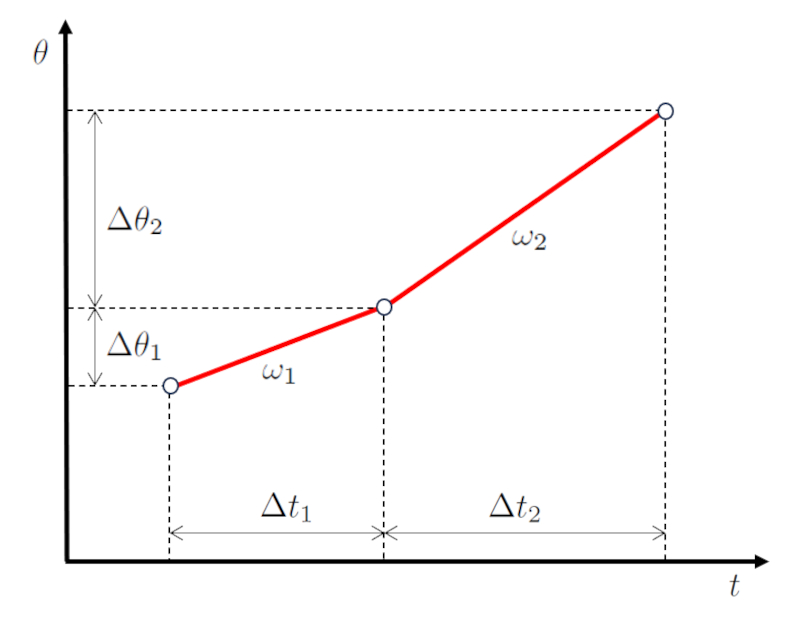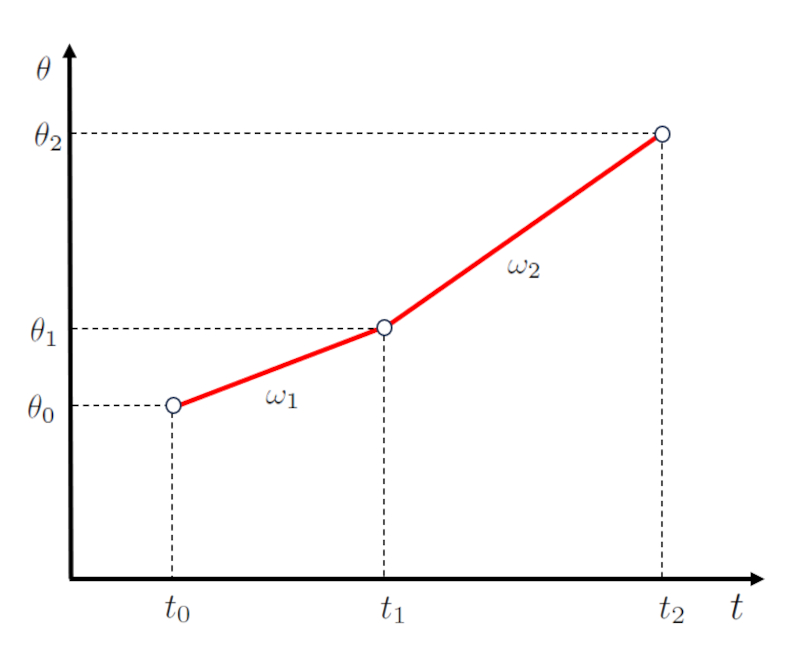Constant angular velocity, two stages
Storyboard 
If during a movement at constant angular velocity there is a change in this velocity, it results in a movement occurring in two stages, each characterized by a defined angular velocity.
Each stage is modeled with a linear relationship represented by a line, where the key lies in the fact that the time and final angle of the first stage are, in turn, the time and initial angle of the second stage.
It's important to note that this model presents a problem: the angular velocity changes instantaneously, which is equivalent to an angular acceleration followed by an infinite deceleration, which is unrealistic. However, this problem is not relevant if the duration of the stages is considerably longer than the time in which the change in angular velocity occurs.
ID:(1410, 0)
Constant angular velocity, two stages
Storyboard 
If during a movement at constant angular velocity there is a change in this velocity, it results in a movement occurring in two stages, each characterized by a defined angular velocity.
Each stage is modeled with a linear relationship represented by a line, where the key lies in the fact that the time and final angle of the first stage are, in turn, the time and initial angle of the second stage.
Variables
Calculations
Calculations
Equations
In the case where the initial Angular Speed ($\omega_0$) is equal to the mean angular velocity ($\bar{\omega}$),
Therefore, with the difference of Angles ($\Delta\theta$), which is equal to the angle ($\theta$) divided by the initial Angle ($\theta_0$), we obtain:
And with the time elapsed ($\Delta t$), which is equal to the time ($t$) divided by the start Time ($t_0$), we obtain:
We can rewrite the equation for the mean angular velocity ($\bar{\omega}$) as:
This can be expressed as:
$\omega_0 = \omega = \displaystyle\frac{\Delta\theta}{\Delta t} = \displaystyle\frac{\theta - \theta_0}{t - t_0}$
Solving for it, we get:
In the case where the initial Angular Speed ($\omega_0$) is equal to the mean angular velocity ($\bar{\omega}$),
Therefore, with the difference of Angles ($\Delta\theta$), which is equal to the angle ($\theta$) divided by the initial Angle ($\theta_0$), we obtain:
And with the time elapsed ($\Delta t$), which is equal to the time ($t$) divided by the start Time ($t_0$), we obtain:
We can rewrite the equation for the mean angular velocity ($\bar{\omega}$) as:
This can be expressed as:
$\omega_0 = \omega = \displaystyle\frac{\Delta\theta}{\Delta t} = \displaystyle\frac{\theta - \theta_0}{t - t_0}$
Solving for it, we get:
As the mean Speed ($\bar{v}$) is with the distance traveled in a time ($\Delta s$) and the time elapsed ($\Delta t$), equal to
and with the distance traveled in a time ($\Delta s$) expressed as an arc of a circle, and the radius ($r$) and the angle variation ($\Delta\theta$) are
and the definition of the mean angular velocity ($\bar{\omega}$) is
then,
$v=\displaystyle\frac{\Delta s}{\Delta t}=r\displaystyle\frac{\Delta\theta}{\Delta t}=r\omega$
Since the relationship is general, it can be applied for instantaneous values, resulting in
As the mean Speed ($\bar{v}$) is with the distance traveled in a time ($\Delta s$) and the time elapsed ($\Delta t$), equal to
and with the distance traveled in a time ($\Delta s$) expressed as an arc of a circle, and the radius ($r$) and the angle variation ($\Delta\theta$) are
and the definition of the mean angular velocity ($\bar{\omega}$) is
then,
$v=\displaystyle\frac{\Delta s}{\Delta t}=r\displaystyle\frac{\Delta\theta}{\Delta t}=r\omega$
Since the relationship is general, it can be applied for instantaneous values, resulting in
The definition of the mean angular velocity ($\bar{\omega}$) is considered as the angle variation ($\Delta\theta$),
and the time elapsed ($\Delta t$),
The relationship between both is defined as the mean angular velocity ($\bar{\omega}$):
The definition of the mean angular velocity ($\bar{\omega}$) is considered as the angle variation ($\Delta\theta$),
and the time elapsed ($\Delta t$),
The relationship between both is defined as the mean angular velocity ($\bar{\omega}$):
Examples
A body can move to the first stage angular velocity ($\omega_1$) and then transition to a the second stage angular velocity ($\omega_2$). This marks the beginning of a new stage, and it's necessary to describe both mathematically in order to predict their motion.
The key is to note that both stages have a common point characterized by:
• The final angle of the first stage and the initial angle of the second stage, the first final angle and second stage began ($\theta_1$).
• The final time of the first stage and the initial time of the second stage, the final time of first and start of second stage ($t_1$).
With this, the diagrams of angle over time can be coupled as shown in the following representation:
In a scenario of movement in two stages, first the object advances a angle traveled in the first stage ($\Delta\theta_1$) during a time spent in the first stage ($\Delta t_1$) with a first stage angular velocity ($\omega_1$).
Subsequently, in the second stage, it advances a angle traveled in the second stage ($\Delta\theta_2$) during a time spent in the second stage ($\Delta t_2$) with a second stage angular velocity ($\omega_2$).
When representing this graphically, we obtain an angle and time diagram as shown below:
The key here is that the values the time spent in the first stage ($\Delta t_1$) and the time spent in the second stage ($\Delta t_2$) are sequential, just like the values the angle traveled in the first stage ($\Delta\theta_1$) and the angle traveled in the second stage ($\Delta\theta_2$).
In the case of a two-stage movement, the first stage can be described by a function involving points the start Time ($t_0$), the final time of first and start of second stage ($t_1$), the initial Angle ($\theta_0$), and the first final angle and second stage began ($\theta_1$), represented by a line with a slope of the first stage angular velocity ($\omega_1$):
For the second stage, defined by points the first final angle and second stage began ($\theta_1$), the second stage final angle ($\theta_2$), the final time of first and start of second stage ($t_1$), and the second stage ending time ($t_2$), a second line with a slope of the second stage angular velocity ($\omega_2$) is used:
which is represented as:
It is important to note that the beginning of the second stage, defined by points the final time of first and start of second stage ($t_1$) and the first final angle and second stage began ($\theta_1$), coincides with the end of the first stage.
To describe the rotation of an object, we need to determine the angle variation ($\Delta\theta$). This is achieved by subtracting the initial Angle ($\theta_0$) from the angle ($\theta$), which is reached by the object during its rotation:
To describe the rotation of an object, we need to determine the angle variation ($\Delta\theta$). This is achieved by subtracting the initial Angle ($\theta_0$) from the angle ($\theta$), which is reached by the object during its rotation:
To describe the motion of an object, we need to calculate the time elapsed ($\Delta t$). This magnitude is obtained by measuring the start Time ($t_0$) and the the time ($t$) of said motion. The duration is determined by subtracting the initial time from the final time:
To describe the motion of an object, we need to calculate the time elapsed ($\Delta t$). This magnitude is obtained by measuring the start Time ($t_0$) and the the time ($t$) of said motion. The duration is determined by subtracting the initial time from the final time:
In the case where the angular velocity is constant, the mean angular velocity ($\bar{\omega}$) coincides with the value of the initial Angular Speed ($\omega_0$), so
In this scenario, we can calculate the angle traveled as a function of time by recalling that it is associated with the difference between the current and initial angles, as well as the current and initial time. Therefore, the angle ($\theta$) is equal to the initial Angle ($\theta_0$), the initial Angular Speed ($\omega_0$), the time ($t$), and the start Time ($t_0$) as shown below:
The equation represents a straight line in angle-time space.
In the case where the angular velocity is constant, the mean angular velocity ($\bar{\omega}$) coincides with the value of the initial Angular Speed ($\omega_0$), so
In this scenario, we can calculate the angle traveled as a function of time by recalling that it is associated with the difference between the current and initial angles, as well as the current and initial time. Therefore, the angle ($\theta$) is equal to the initial Angle ($\theta_0$), the initial Angular Speed ($\omega_0$), the time ($t$), and the start Time ($t_0$) as shown below:
The equation represents a straight line in angle-time space.
To estimate the displacement of an object, it's necessary to know its the angular Speed ($\omega$) as a function of the time ($t$). Therefore, the the mean angular velocity ($\bar{\omega}$) is introduced, defined as the ratio between the angle variation ($\Delta\theta$) and the time elapsed ($\Delta t$).
To measure this, a system like the one shown in the image can be used:
To determine the average angular velocity, a reflective element is placed on the axis or on a disk with several reflective elements, and the passage is recorded to estimate the length of the arc $\Delta s$ and the angle associated with the radius $r$. Then the time difference when the mark passes in front of the sensor is recorded as $\Delta t$. The average angular velocity is determined by dividing the angle traveled by the time elapsed.
The equation that describes the average angular velocity is:
It should be noted that the average velocity is an estimation of the actual angular velocity. The main problem is that:
If the angular velocity varies during the elapsed time, the value of the average angular velocity can be very different from the average angular velocity.
Therefore, the key is:
Determine the velocity in a sufficiently short elapsed time to minimize its variation.
To estimate the displacement of an object, it's necessary to know its the angular Speed ($\omega$) as a function of the time ($t$). Therefore, the the mean angular velocity ($\bar{\omega}$) is introduced, defined as the ratio between the angle variation ($\Delta\theta$) and the time elapsed ($\Delta t$).
To measure this, a system like the one shown in the image can be used:
To determine the average angular velocity, a reflective element is placed on the axis or on a disk with several reflective elements, and the passage is recorded to estimate the length of the arc $\Delta s$ and the angle associated with the radius $r$. Then the time difference when the mark passes in front of the sensor is recorded as $\Delta t$. The average angular velocity is determined by dividing the angle traveled by the time elapsed.
The equation that describes the average angular velocity is:
It should be noted that the average velocity is an estimation of the actual angular velocity. The main problem is that:
If the angular velocity varies during the elapsed time, the value of the average angular velocity can be very different from the average angular velocity.
Therefore, the key is:
Determine the velocity in a sufficiently short elapsed time to minimize its variation.
If we divide the relationship between the distance traveled in a time ($\Delta s$) and the radius ($r$) by the angle variation ($\Delta\theta$),
and then divide it by the time elapsed ($\Delta t$), we obtain the relationship that allows us to calculate the speed ($v$) along the orbit, known as the tangential velocity, which is associated with the angular Speed ($\omega$):
If we divide the relationship between the distance traveled in a time ($\Delta s$) and the radius ($r$) by the angle variation ($\Delta\theta$),
and then divide it by the time elapsed ($\Delta t$), we obtain the relationship that allows us to calculate the speed ($v$) along the orbit, known as the tangential velocity, which is associated with the angular Speed ($\omega$):
ID:(1410, 0)



